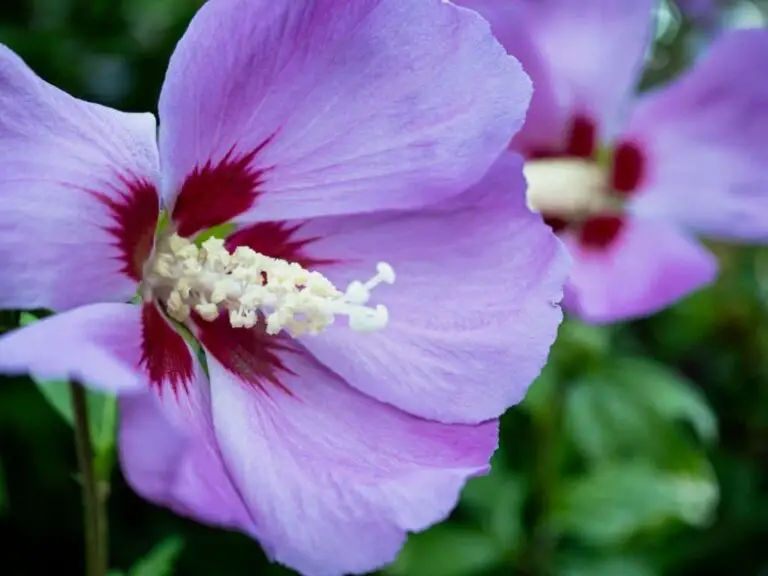35+ Different Types Of Hibiscus: A Comprehensive Guide (With Pictures)
With over 350 species to explore, hibiscus flowers are a true marvel of nature. From their vibrant colors to their unique shapes and sizes, each type of hibiscus has its own distinct characteristics. Whether you’re an experienced gardener or just starting out, understanding the different types of hibiscus can help you grow and care for these beautiful plants. In this comprehensive guide, we’ll delve into the world of hibiscus, exploring everything from the rose mallow to the spider hibiscus.
We’ll also provide valuable tips on how to nurture your hibiscus plants and keep them thriving. If you’re ready to learn more about these stunning flowers, let’s dive in! Some of the most popular types of hibiscus include Hibiscus ‘Cherry Cheesecake’, Hibiscus acetosella, Hibiscus arnottianus, and many others. Each type has its own unique characteristics, from the vibrant colors of Hibiscus ‘Berry Awesome’ to the delicate petals of Hibiscus coccineus.
In addition to learning about the different types of hibiscus, we’ll also explore some of the most common questions people have about these plants, including what makes a hardy hibiscus and what colors they come in. With this guide, you’ll be well on your way to becoming a hibiscus expert and growing these beautiful flowers with ease.
Hibiscus flowers
Hibiscus flowers are truly captivating, boasting a range of vibrant colors including red, pink, orange, and white. With five delicate petals and an average diameter of six inches, these tropical blooms exude elegance and uniqueness. Native to Asia, the hibiscus has since spread to various parts of the world, making it a popular choice for floral arrangements and decorative pieces.
Not only are they stunning on their own, but hibiscus flowers can also be dried and used in potpourris, adding an extra layer of versatility to their appeal. Furthermore, their beauty and uniqueness make them a sought-after choice for weddings, where they serve as a lovely reminder of the special occasion.
Hibiscus leaves
Distinctive in appearance, hibiscus leaves boast large, leathery foliage with a unique shape that makes them readily identifiable. Characterized by their dark green hue, pointed tips, and serrated edges, these leaves stand out from others of similar species. Additionally, the visible veins on their surface provide an added layer of distinction.
Different Types Of Hibiscus
Hibiscus ‘Cherry Cheesecake’ (Rose Mallow)
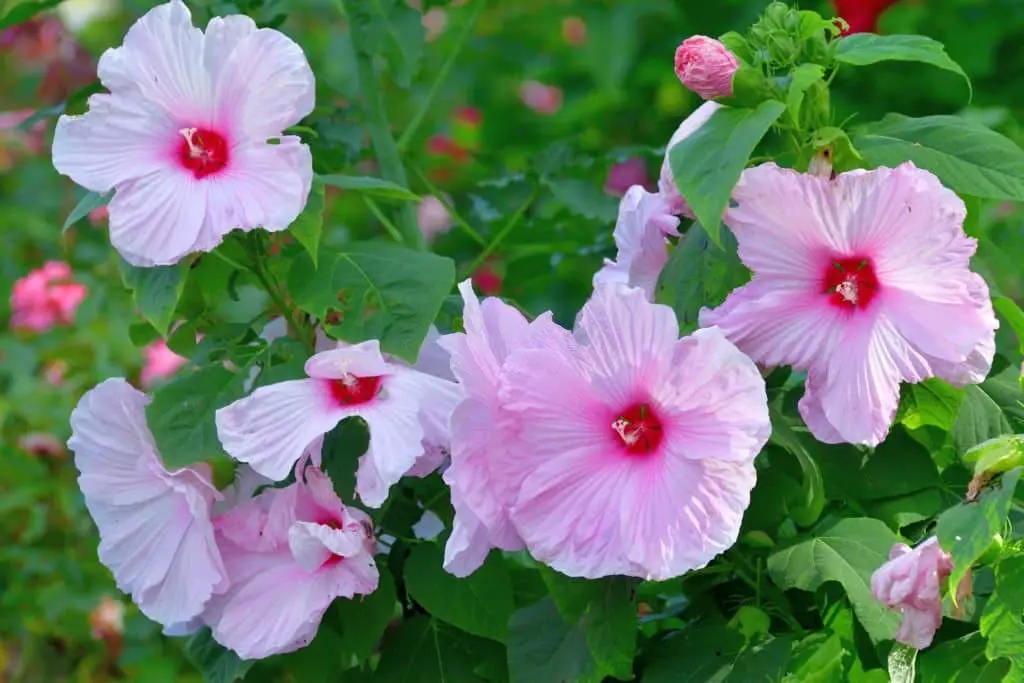
One of the most striking plants I’ve had the pleasure of growing is Hibiscus ‘Cherry Cheesecake’. Its breathtaking blooms boast vibrant red petals with creamy white edges and a delicate center that seem almost hand-painted. The flowers erupt on sturdy stems reaching up to six feet tall, creating a stunning display that persists throughout the summer season.
While it’s unfortunate that these magnificent blooms have a relatively short lifespan, lasting only a day or two, their beauty is undeniable, making them well worth any temporary drawbacks.
Hibiscus acetosella (Cranberry hibiscus)

Hibiscus acetosella, a species of hibiscus native to Ethiopia, Somalia, and Kenya, boasts a unique distinction – it’s the national flower of Malaysia. As a tropical plant, it thrives in warm, humid conditions, making it an ideal choice for greenhouses or indoor spaces that mimic its natural environment. While it can tolerate partial shade, Hibiscus acetosella does best in full sun, where it can reach impressive heights of up to six feet.
Its fast growth rate allows it to quickly fill a space and add a pop of color with its vibrant blooms. In addition to its striking appearance, the leaves of Hibiscus acetosella are also edible, making it a versatile plant for gardeners who enjoy cooking and experimenting with new flavors. They can be used in salads or cooked as a green vegetable, offering a delicious and nutritious addition to any meal.
The flowers themselves are also edible and can be added to salads or desserts for a touch of tropical flair. Overall, Hibiscus acetosella is a beautiful plant that makes an excellent addition to any garden or landscape, whether it’s a small backyard oasis or a sprawling estate. Its unique features and versatility make it a standout choice for anyone looking to add some tropical charm to their outdoor space.
Hibiscus arnottianus (Hawaiian white hibiscus, Koki’o ke’oke’o)
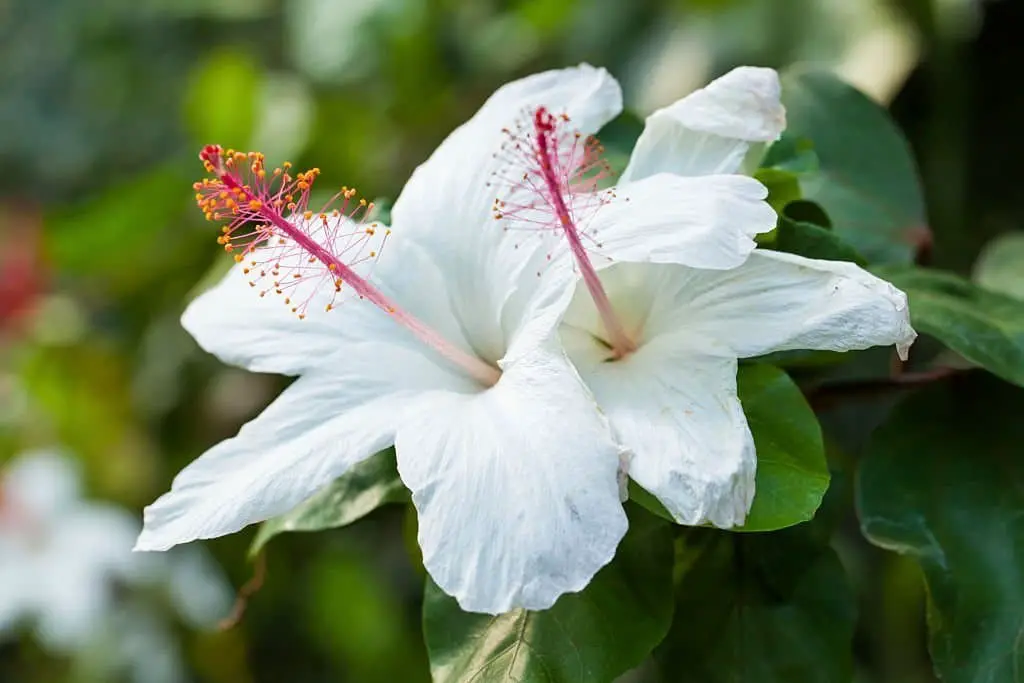
The Hawaiian white hibiscus (Hibiscus arnottianus) is an endemic species to the Hawaiian Islands, belonging to the Malvaceae family. This evergreen plant thrives in moist, shaded environments at elevations ranging from sea level to approximately 3,000 feet. Its leaves exhibit a range of shapes, typically broad and lobed, measuring around 12 inches long and 18 inches wide. The plant’s white flowers, measuring about four inches in diameter, bloom from June to October.
The fruit is a dark brown or black capsule, roughly one inch in diameter. Beyond its ornamental value in gardens, the Hawaiian white hibiscus is also cultivated for its edible flowers used in traditional leis and as a food source. Additionally, the plant’s hard wood has been utilized for crafting tools and weapons. Notably, this species is listed as threatened by the state of Hawaii due to conservation concerns.
Hibiscus ‘Berry Awesome’ (Hibiscus moscheutos ‘Berry Awesome’)
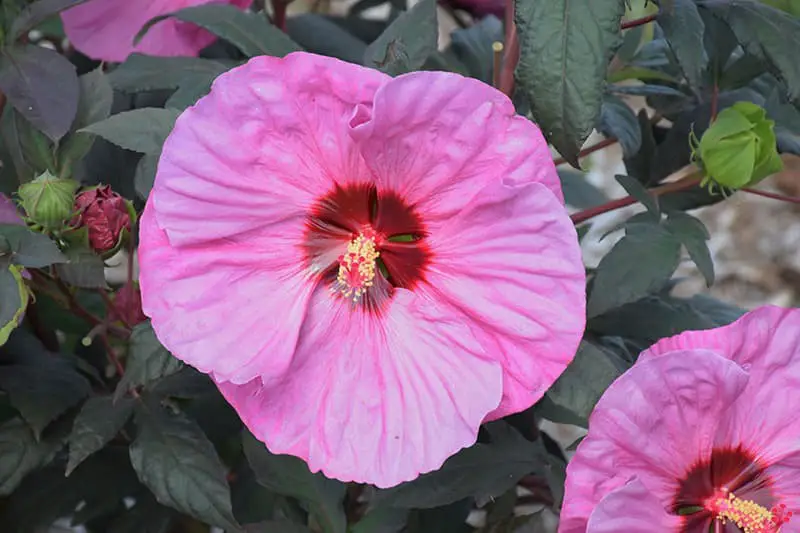
Hibiscus ‘Berry Awesome’ is a show-stopping variety that produces massive, dinner plate-sized flowers with rich magenta petals and deep crimson throats. These vibrant blooms adorn the dark green foliage from late summer to early fall, making this plant an absolute must-have for adding dramatic color to any garden. Developed by Dr.
Dennis Werner of the NC State University Plant Breeding Program through a cross between Hibiscus moscheutos and Hibiscus coccineus, this hybrid hibiscus is known for its vigor and ease of growth. Its large, showy flowers will attract hummingbirds and butterflies, drawing attention to your garden’s beauty. With the ability to thrive in full sun or partial shade, and a tolerance for a wide range of soil types, Hibiscus ‘Berry Awesome’ can be grown in USDA Hardiness Zones A-D.
This stunning plant is sure to make a statement in any outdoor space!
Hibiscus calyphyllus (lemonyellow rosemallow)
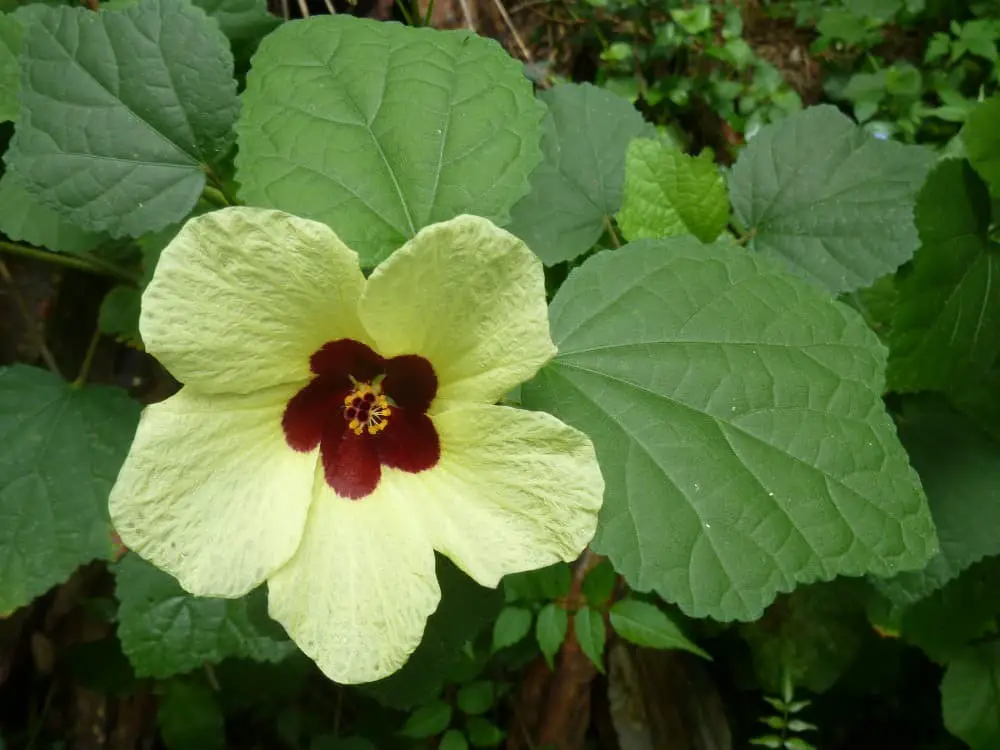
Hibiscus calyphyllus, a native West Indian species, thrives on many islands, as well as in Mexico, Central America, and South America, extending its range to Peru. The plant’s striking lemon-yellow blooms boast five petals and can reach up to 12 cm in width. Leaves exhibit varying shapes, often featuring deep lobes, while the plant itself grows to a height of up to 60 cm.
Classified as hardy in USDA zones 11 and 12, this species presents an appealing addition to any garden, drawing bees and butterflies alike. Its flowers are not only visually stunning but also edible, high in Vitamin C, and suitable for fresh consumption or preservation. A versatile plant, Hibiscus calyphyllus can thrive in sun or partial shade, provided well-drained soil is present.
Hibiscus cannabinus (Kenaf)
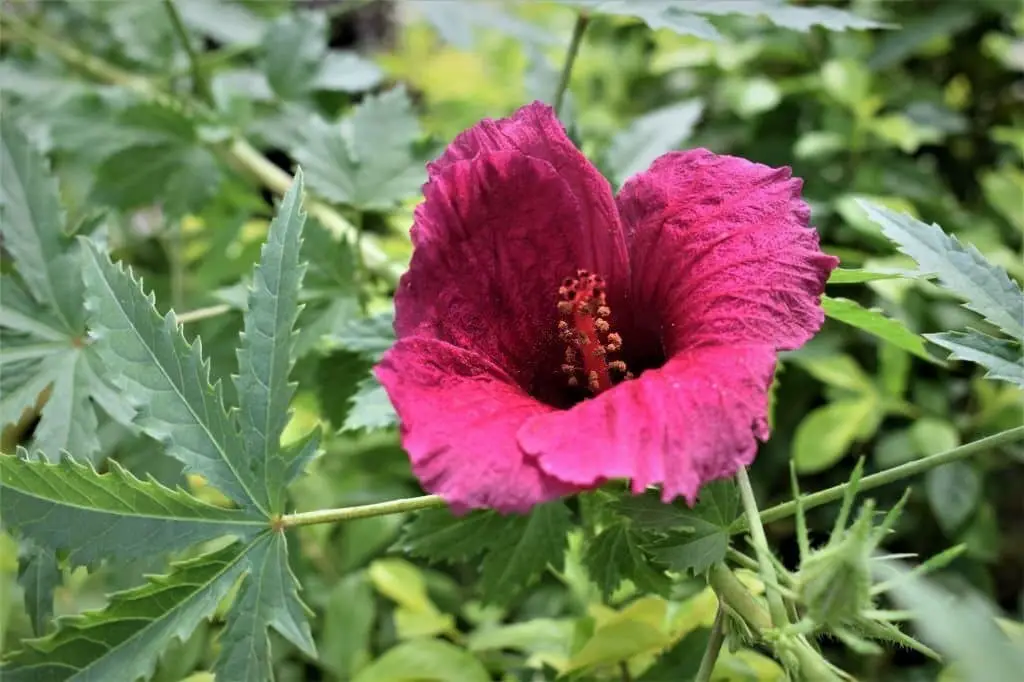
Hibiscus cannabinu, also known as kenaf, is a versatile species with a multitude of uses. Its strong bast fibers are prized for crafting ropes, sacks, carpets, and other textiles, showcasing its remarkable durability. The leaves can be consumed fresh or cooked into various dishes, while the edible flowers often find their way into homemade jams and jellies. As an ornamental plant, kenaf adds a pop of color to any garden.
Native to the Old World tropics, this plant has since spread to Africa, Asia, Australia, North America, and South America, with its introduction to the United States dating back to 1837. Kenaf is known for its rapid growth, reaching heights of up to 20 feet, and thrives in warm, moist climates. It can be cultivated as either an annual or perennial. Its vibrant flowers typically bloom in shades of red, though they may also appear in orange, yellow, or white hues.
As a member of the mallow family (Malvaceae), kenaf’s unique characteristics make it an intriguing addition to any ecosystem.
Hibiscus coccineus (Scarlet rosemallow)
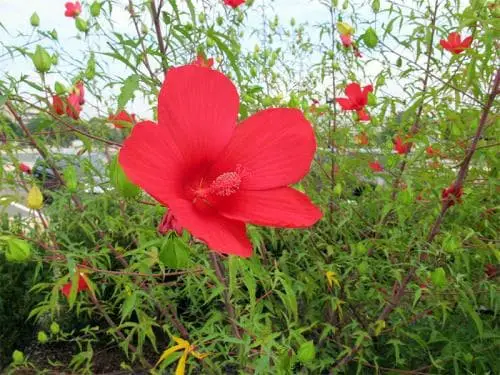
Hibiscus coccineus, also known as scarlet rosemallow, is a perennial herbaceous plant that thrives in the southeastern United States. Its vibrant red flowers are a standout feature, making it one of the most sought-after hibiscus species for garden enthusiasts to cultivate.
Hibiscus denudatus (paleface, rock hibiscus)
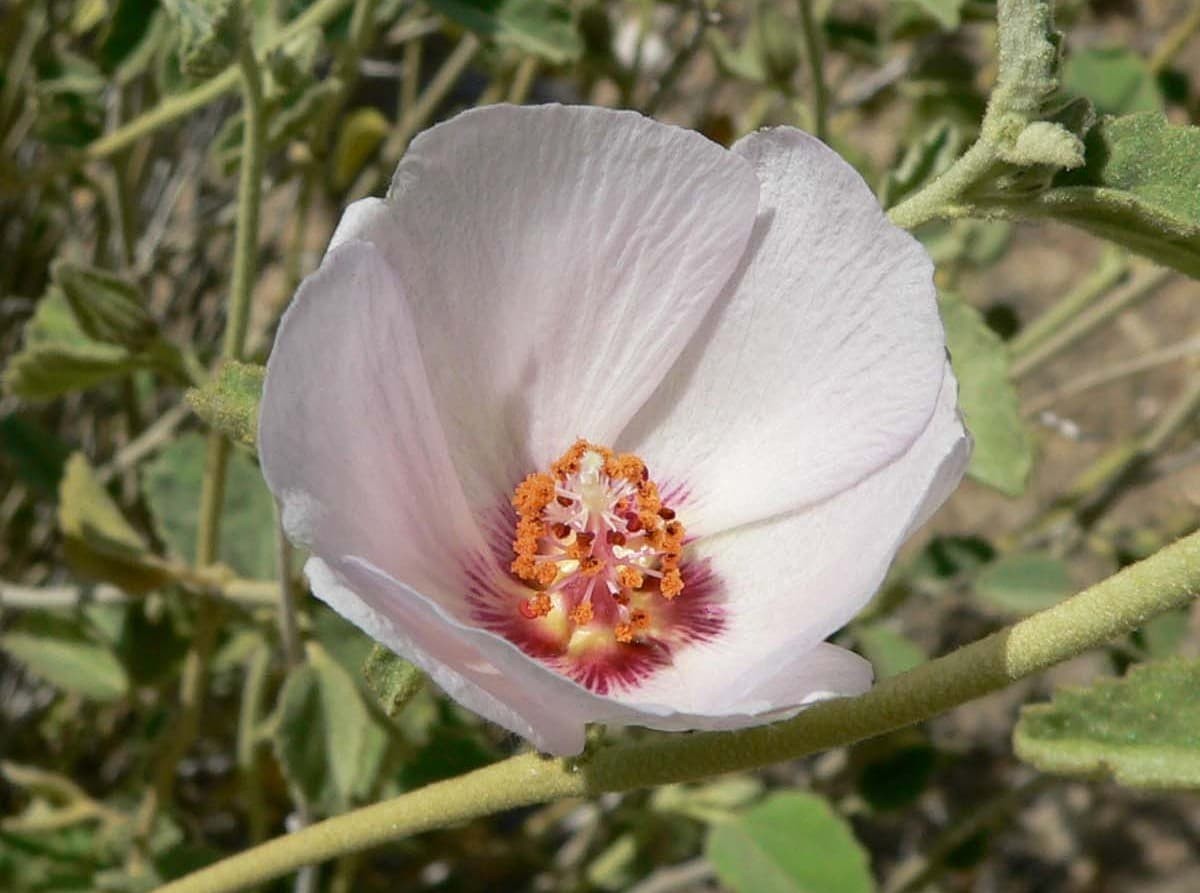
In the dry to moist limestone soils of Texas’s Edwards Plateau and Trans-Pecos regions, Hibiscus denudatus thrives as a small tree or large shrub with a unique character. Its multi-trunked structure and spreading canopy make it a striking addition to any landscape. The tree’s light gray bark is smooth to the touch, featuring prominent lenticels that reveal themselves upon close inspection. The tree’s leaves are a notable feature, measuring up to 12 cm in length and width.
They are alternate, simple, and ovate or elliptical in shape, with a pointed tip and a green upper surface that gradually fades to paler on the underside. Hibiscus denudatus is renowned for its showy flowers, which can reach up to 15 cm in diameter and boast white or light pink petals surrounding a deep red or purple center. These trumpet-shaped blooms cluster at the ends of branches, creating a dramatic display.
The tree’s fruit is a capsule that measures up to 12 cm in length and width, containing numerous seeds. It’s worth noting that Hibiscus denudatus can be distinguished from other Texas hibiscuses by its smooth bark, light green leaves, large flowers with white petals and red centers, and hairy fruit capsules.
While it may be mistaken for Hibiscus clypeatus, which shares similar characteristics but has hairy fruits and a more spreading habit, Hibiscus denudatus stands out as a popular ornamental plant in Texas and beyond. Its versatility makes it an ideal choice for hedges or screens, while its relatively low maintenance requirements mean it can thrive with minimal care once established.
Hibiscus diversifolius (the swamp hibiscus)
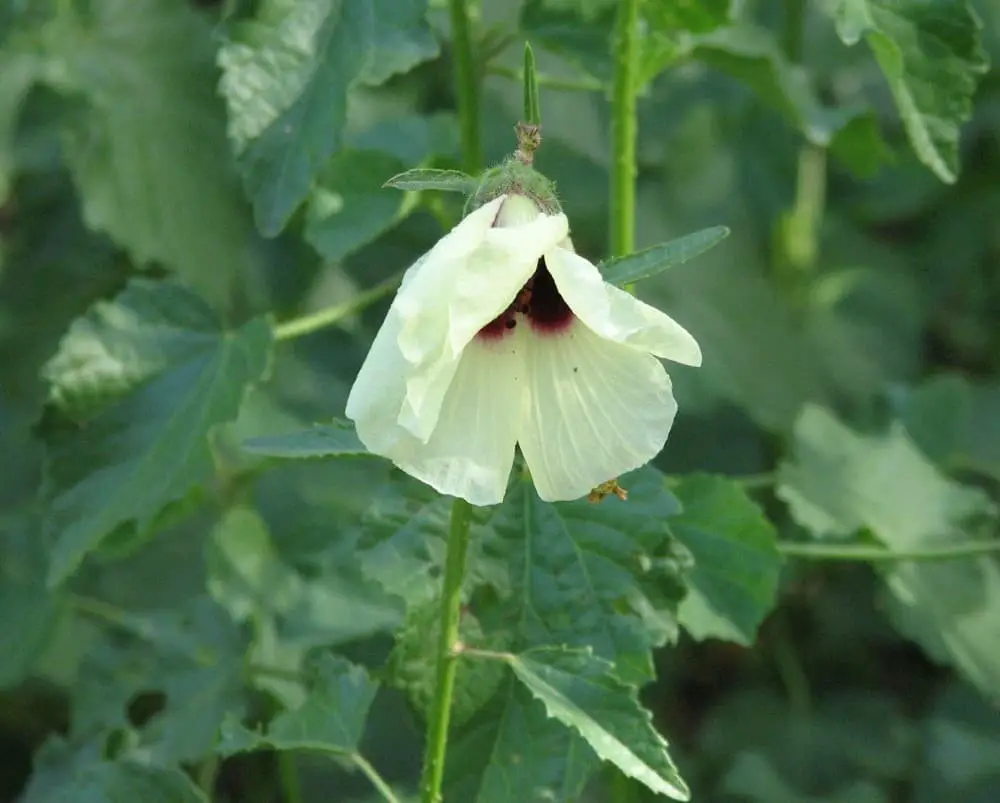
In the eastern and central United States, Hibiscus diversifolius is a thriving wetland plant that’s easily recognizable by its broad, dark green leaves and striking flowers with five petals. The latter come in a range of colors, from pure white to deep red, making for a truly show-stopping sight. While this plant typically thrives in moist soil near ponds or streams, it can also be found in damp woods and meadows, showcasing its remarkable adaptability.
Hibiscus fragilis (the mandrinette)
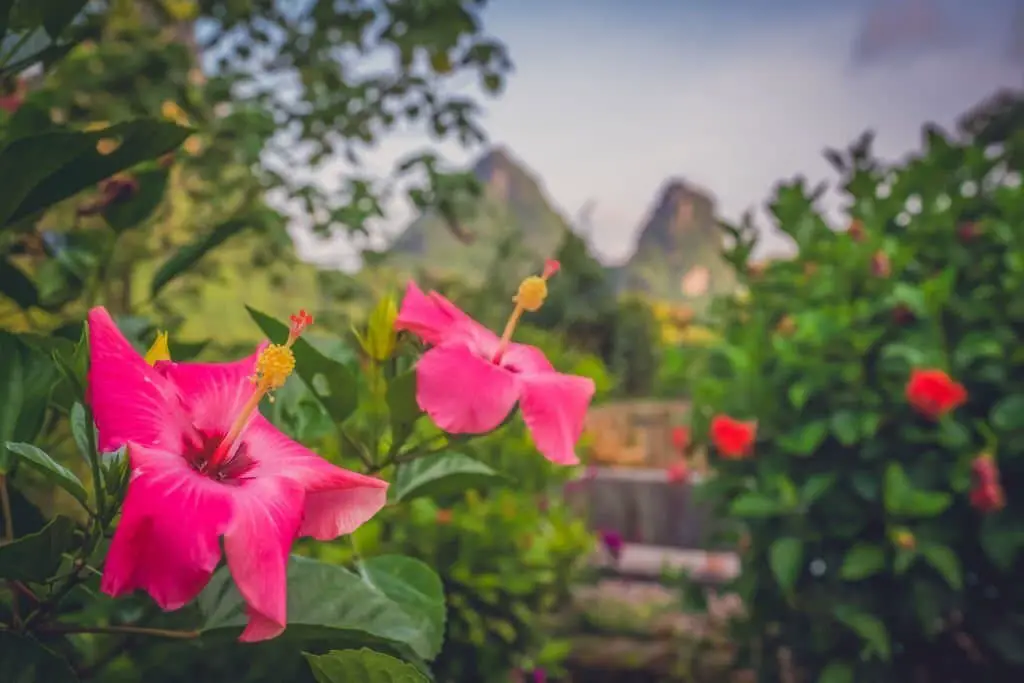
Hibiscus fragilis, also known as the mandrinette, is a stunning species of hibiscus that boasts an array of unique characteristics. Its delicate white flowers feature vibrant purple streaks and measure approximately 12 centimeters in diameter, blooming from mid-summer to early autumn. The plant’s leaves are ovate-acute in shape, reaching lengths of up to 15 centimeters and widths of 12 centimeters. As a shrub, the mandrinette can grow quite tall, reaching heights of up to two meters.
Native to the Mediterranean region, this ornamental plant has been introduced to other parts of the world, including Australia and California, where it is often cultivated in gardens and parks. Interestingly, the flowers are not only visually appealing but also edible, making them a popular choice for fresh consumption or use in jams and jellies.
Hibiscus furcellatus (Hawaiian pink hibiscus)
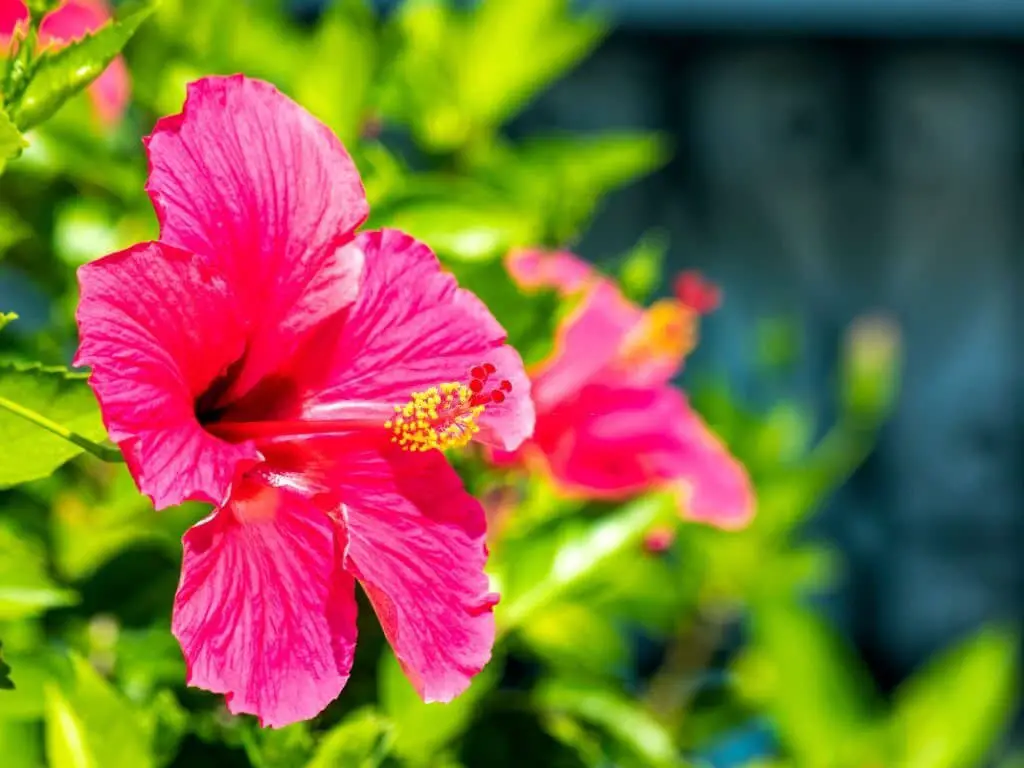
In the lush Hawaiian Islands, a unique species of hibiscus thrives – Hibiscus furcellatus, also known as the Hawaiian pink hibiscus. This evergreen shrub or small tree reaches heights of approximately 15 feet (4.5 meters), its large leaves stretching up to 12 inches (30 cm) in length and width. The showy flowers are a striking feature, boasting red or pink petal tubes and white or yellow petals that cluster at the branch ends from late winter to early summer.
As the seasons change, the fruit ripens into green or red capsules, roughly an inch (2.5 cm) long. This ornamental plant is prized for its beauty in gardens worldwide, while its flowers are used to craft traditional leis and savored as a culinary delicacy. The fruit also finds use in homemade jams and jellies. Interestingly, the Hawaiian pink hibiscus shares a close genetic bond with its more common counterpart, Hibiscus rosa-sinensis, which originated in Asia.
Hibiscus grandiflorus (Swamp rose-mallow)

Hibiscus grandiflorus, known as swamp rose-mallow or simply rose mallow, is a perennial plant belonging to the hibiscus family, Malvaceae. Native to North America, it can be found in the eastern and southern United States, as well as southeastern Canada. This ornamental flower is also cultivated for its beauty. The cordate to ovate leaves of Hibiscus grandiflorus measure up to 16 cm in length, providing a striking contrast to the plant’s showy flowers.
These trumpet-shaped blooms range in color from white to pink to red and typically bloom during the day before closing at night. In addition to its visually appealing flowers, Hibiscus grandiflorus produces a unique schizocarp fruit that splits into two parts as it matures, each containing one or two seeds. The edible flowers and fruit possess a sweet, musky flavor, while the leaves can also be consumed, although they are somewhat bitter.
Hibiscus hamabo (Hamabo Hibiscus Hardy Yellow Hibiscus)
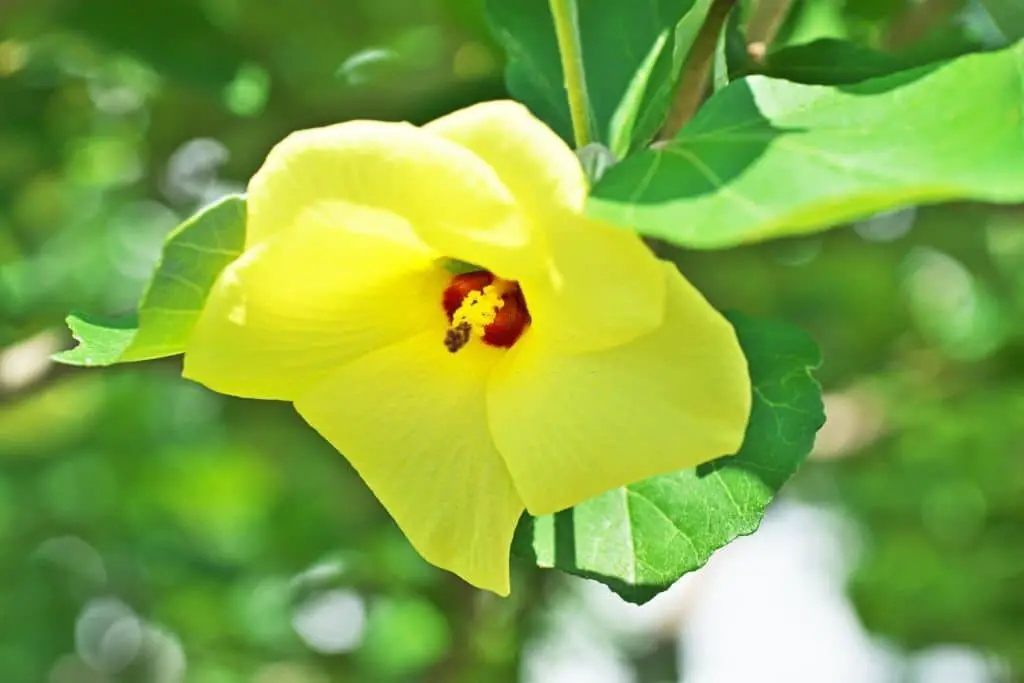
In the realm of botanical wonders, Hibiscus hamabo stands out as a unique and fascinating specimen. Native to Asia, specifically China and Japan, this evergreen shrub boasts an impressive growth habit, reaching up to six feet in height. Its vibrant yellow blooms, adorned with striking red stripes, are a true marvel. As a horticultural gem, Hibiscus hamabo thrives from July to September, filling the air with its radiant beauty.
Not only is this species prized for its stunning flowers, but it also plays an important role in gardens as a popular choice for arrangements. Furthermore, the hibiscus holds a special place in Louisiana’s cultural heritage, serving as the state flower.
Hibiscus heterophyllus (native rosella or toilet paper bush)
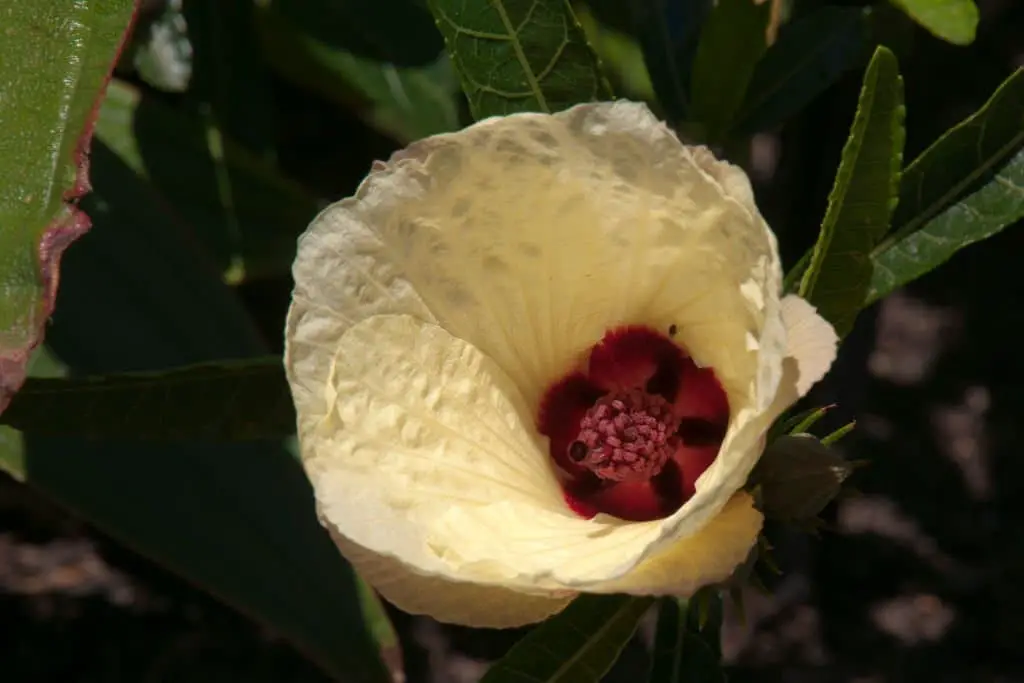
Hibiscus heterophyllus, commonly referred to as native rosella or toilet paper bush, is a flowering plant belonging to the mallow family Malvaceae. Indigenous to Australia and New Guinea, this species exhibits remarkable adaptability, having naturalized in numerous regions around the world. In its native habitat, the shrub grows up to two metres tall, boasting dark green leaves with deep lobes.
During the summer months, vibrant red flowers with five petals emerge, adding a pop of color to the surrounding environment. As pua aloalo in Hawaii and a sought-after garden specimen globally, Hibiscus heterophyllus is cherished for its stunning blooms.
Hibiscus insularis (the Phillip Island hibiscus)

The Phillip Island hibiscus, scientifically known as Hibiscus insularis, is a compact shrub that reaches heights of up to 0.75 metres. Its leaves are a deep green hue, while its flowers burst forth with vibrant pink petals. Measuring approximately six centimetres in diameter, the blooms feature five delicate petals. Native to Phillip Island in Victoria, Australia, this hibiscus species thrives in heathland and forest environments.
As a member of the Malvaceae family, which also includes cotton and hollyhocks, it shares a close affinity with the rose of Sharon (Hibiscus syriacus). Interestingly, Hibiscus insularis was first formally documented by botanist Robert Brown in 1827, marking its entry into the botanical record.
Hibiscus laevis (Halberdleaf rosemallow)
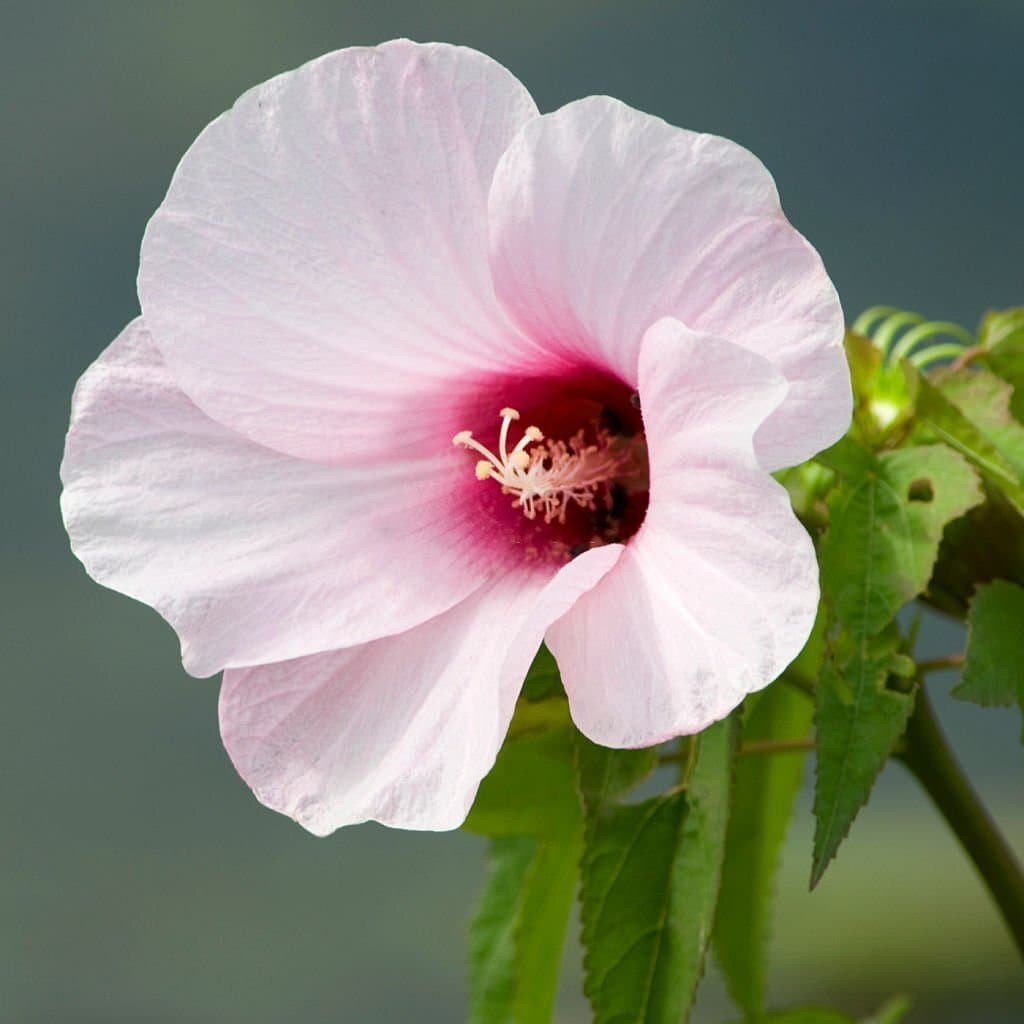
Hibiscus laevis is a hardy perennial that boasts impressive stature, reaching heights of up to six feet. Its robust leaves stretch up to eighteen inches in length and ten inches in width, supported by lengthy petioles. The flowers themselves are the true showstoppers, featuring five-petaled blooms in rosy-purple or pure white hues that unfurl from late summer into fall. With its adaptability to thrive in moist, fertile soil under full sun or partial shade, H.
laevis is an ideal choice for sprawling gardens or native plant meadows. Its tendency to self-seed and spread over time makes it well-suited for larger plots, where it can freely propagate and add a pop of color to the landscape.
Hibiscus lasiocarpos (Woolly rose-mallow)

Hibiscus lasiocarpos, commonly known as the Woolly rose-mallow, is a perennial native to the southeastern United States. As a member of the Hibiscus genus, it belongs to the mallow family, Malvaceae. This species thrives in wetland environments, including swamps, marshes, and floodplains, where it can grow up to six feet tall.
Characterized by its large, woolly leaves and vibrant pink or white flowers, Woolly rose-mallow is a striking plant that blooms from June to September.
Its unique features and adaptability have allowed it to flourish in its native habitat.
Hibiscus moscheutos (swamp rose mallow)
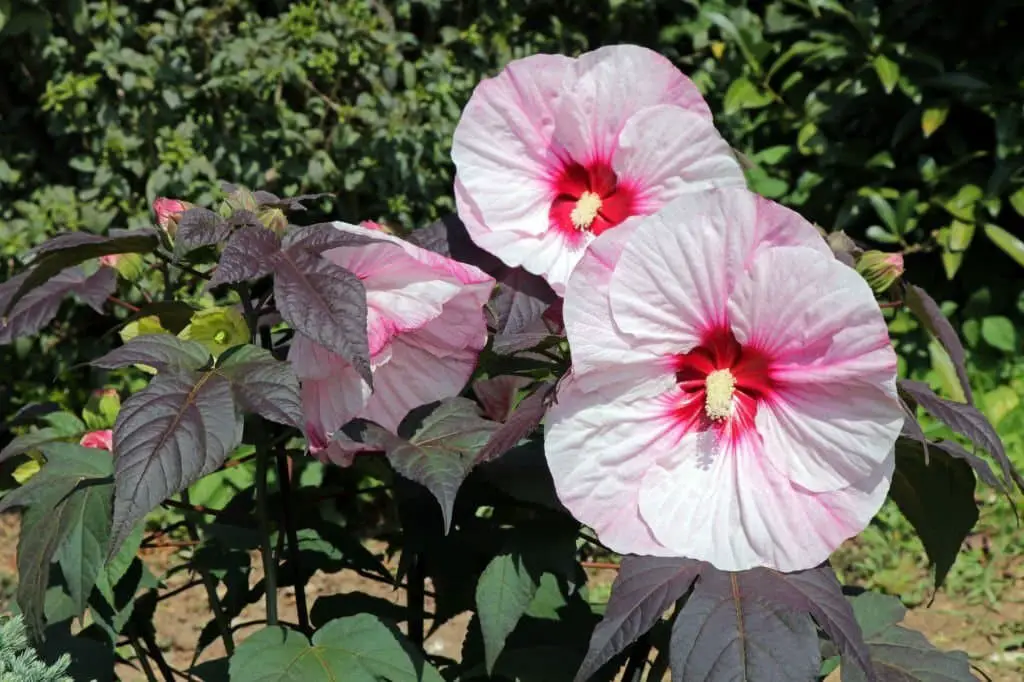
Hibiscus moscheutos, commonly referred to as swamp rose mallow, is a striking perennial herbaceous flowering plant belonging to the Malvaceae family. This impressive plant thrives in wet environments, such as marshes, swamps, and riverbanks. One of its most notable features is its vibrant display of showy flowers, which can be found in a range of colors including white, pink, red, and purple.
Hibiscus moscheutos ‘Airbrush Effect’
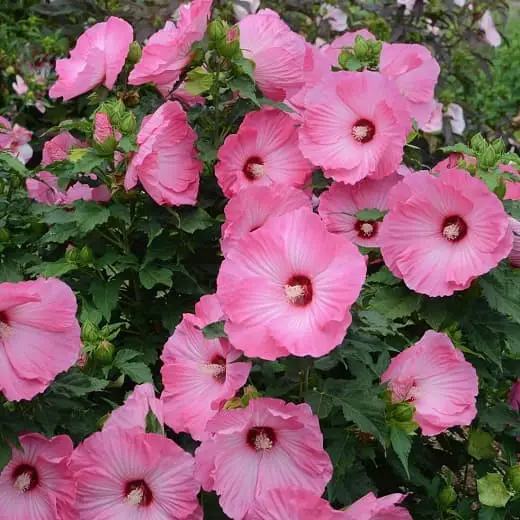
Hibiscus moscheutos ‘Airbrush Effect’ boasts an extraordinary appearance, showcasing variegated foliage that combines the warmth of green and white hues with a subtle pink undertone at its center. This captivating variety is ideal for elevating your garden’s visual appeal. The plant’s adaptability to full sun or partial shade, paired with its tolerance for a broad range of soil types, makes it an easy addition to any outdoor space.
With its ability to thrive in various conditions, ‘Airbrush Effect’ is sure to bring beauty and intrigue to any garden setting.
Hibiscus Moscheutos ‘Luna Red’ (Hardy Hibiscus ‘Luna Red’)
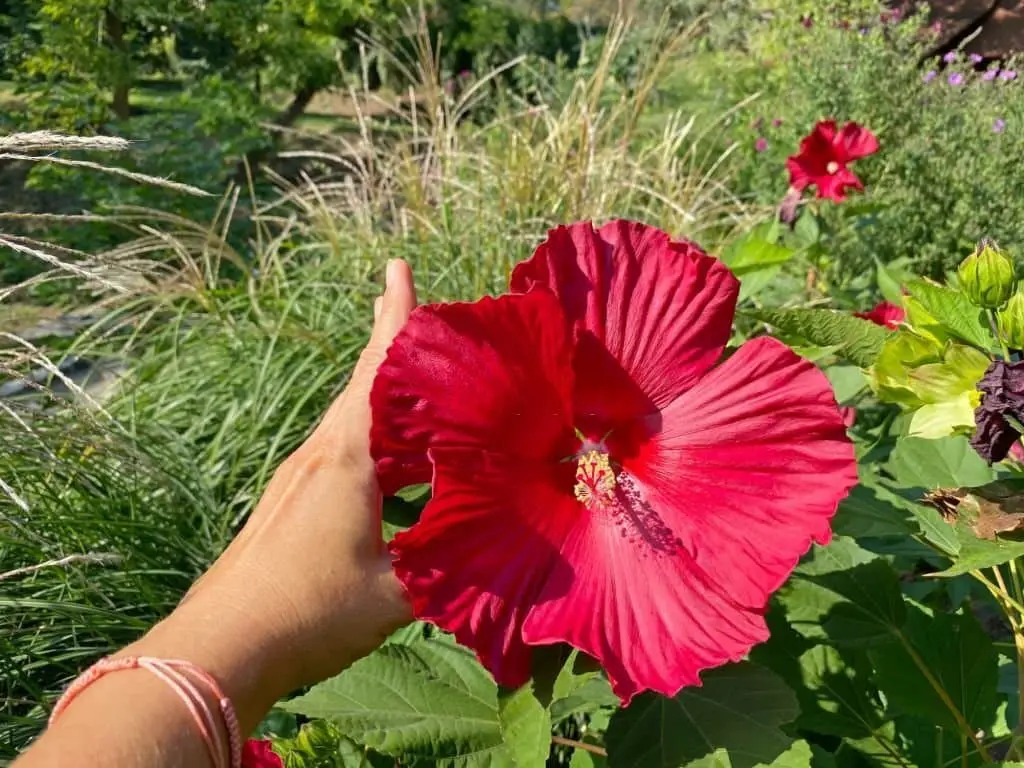
Hibiscus Moscheutos ‘Luna Red’ is a cultivated variety of the species Hibiscus moscheutos, developed by Dr. Bob Polomski at Clemson University in South Carolina, USA. This deciduous shrub stands between 0.75 and 0.83 meters tall, with a spread of approximately 0.91 meters. The leaves are ovate to cordate in shape, featuring toothed margins that reach up to 20 cm in length and 15 cm in width. The plant’s striking red flowers can grow up to 15 cm in diameter and bloom from July to September.
Notably, Hibiscus Moscheutos ‘Luna Red’ is hardy to USDA Zone 5a, making it suitable for outdoor cultivation in areas with cold winters.
Hibiscus mutabilis (Confederate rose)
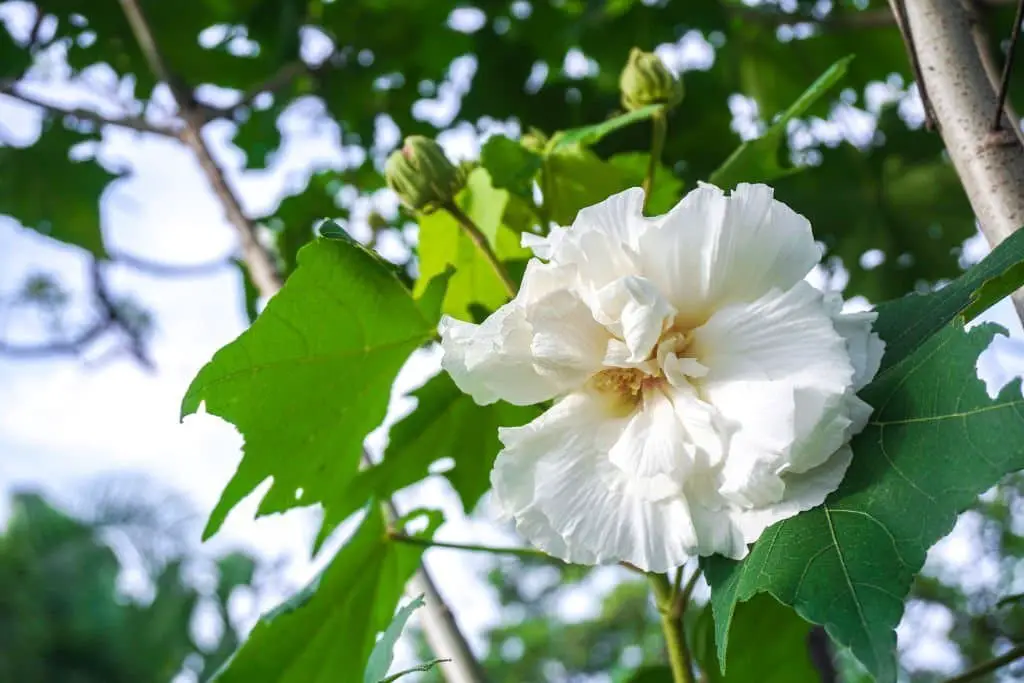
Hibiscus mutabilis, commonly referred to as the Confederate rose or Louisiana hibiscus, is a flowering shrub native to China, but has since been introduced to other parts of Asia and North America. This plant thrives in a variety of environments, with some specimens reaching heights of up to 15 feet.
The flowers are particularly striking, boasting five large and showy petals that can be white, pink, or red in color.
Their long-lasting nature, persisting for several days when cut, has made them a popular choice among gardeners.
What sets the Confederate rose apart is its adaptability to different growing conditions – it can thrive in both full sun and partial shade, as well as tolerate dry and moist soils with ease. This hardiness also extends to its ability to withstand cold temperatures down to around 0 degrees Fahrenheit, making it a reliable addition to any garden.
As an added benefit, the Confederate rose is naturally resistant to common insect pests and diseases, minimizing the need for pesticides or other chemicals. Its versatility has made it a popular choice for use in flower beds, borders, and as a standalone specimen plant. It can also be easily containerized, providing homeowners with even more flexibility in their gardening endeavors.
Hibiscus rosa-sinensis (Chinese hibiscus, shoeblack plant)
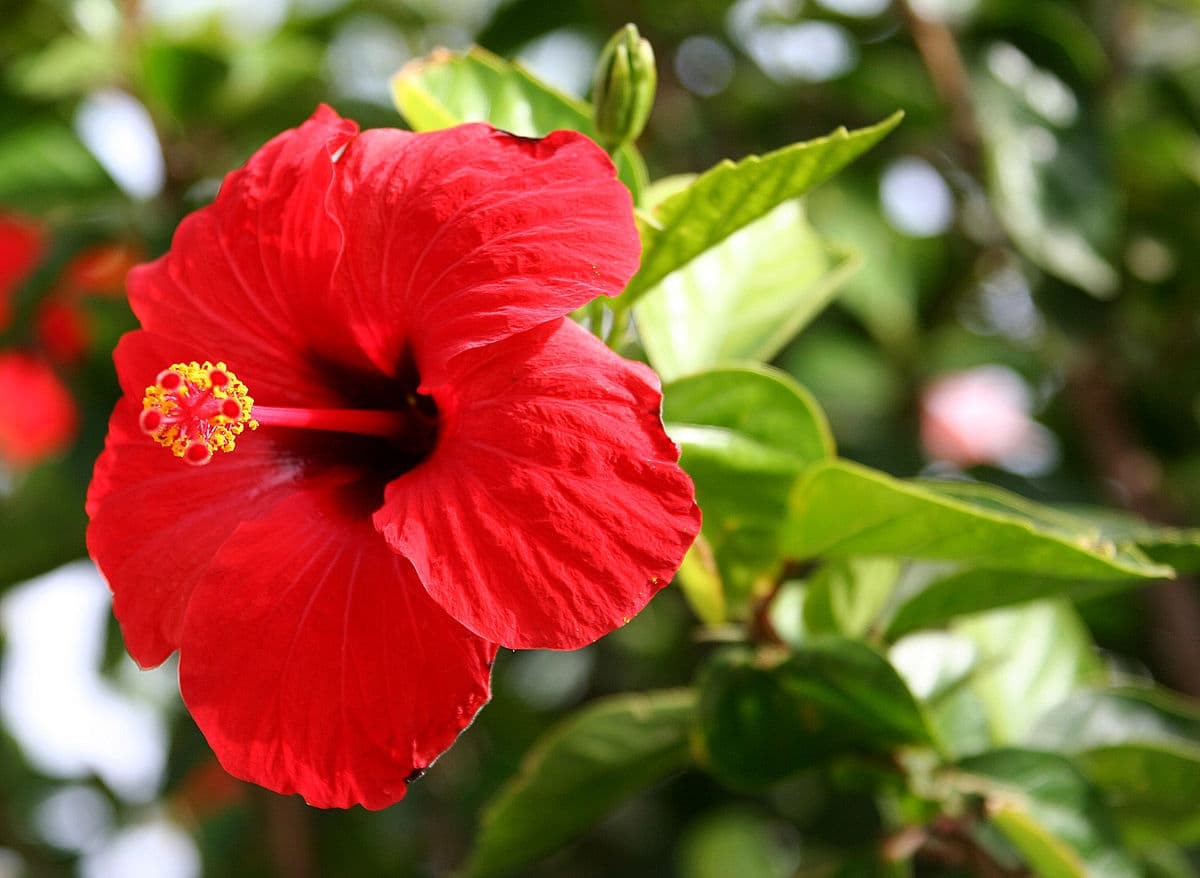
Native to East Asia, Hibiscus rosa-sinensis is a species of flowering plant that thrives within the Hibiscus family. Its popularity stems from its extensive cultivation across various regions, largely driven by its stunning flowers. Characterized by large blooms boasting five or more petals, this ornamental beauty presents itself in a kaleidoscope of colors – red, pink, orange, yellow, and white – making it a sought-after attraction in many gardens.
Hibiscus rosa-sinensis ‘Brilliant’ (Chinese Hibiscus ‘Brilliant’)
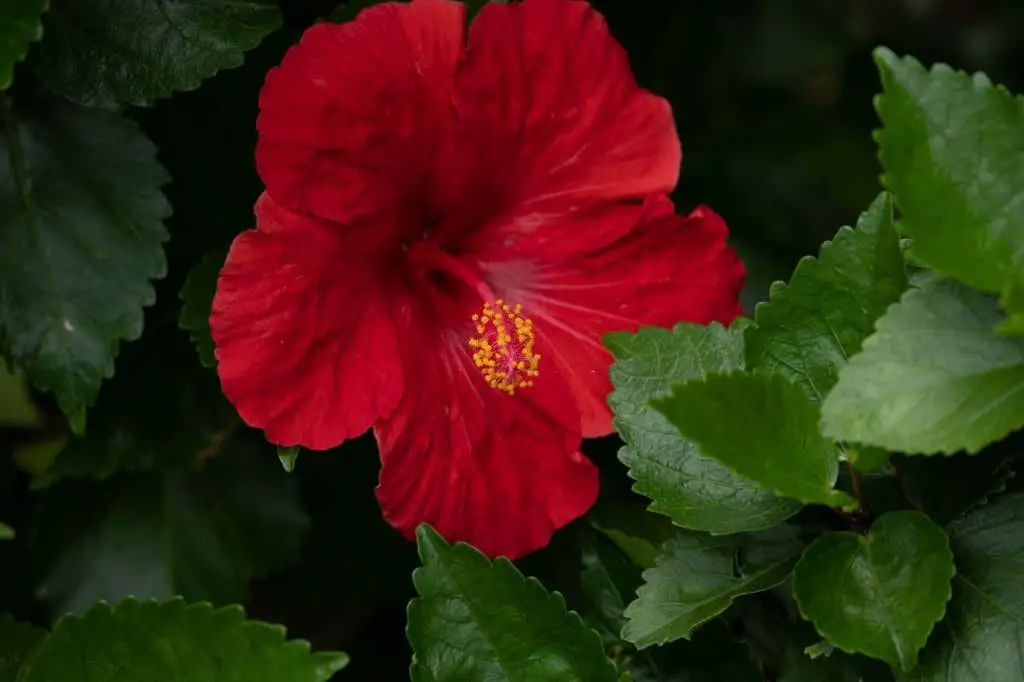
The Hibiscus rosa-sinensis ‘Brilliant’ cultivar boasts vibrant red flowers that contrast beautifully with its dark green leaves. As a popular choice in tropical and subtropical regions, this variety excels in full sun and well-drained soil. With a relatively fast growth rate, it can reach up to six feet tall, making it an ideal candidate for containers or as a striking accent plant in the landscape.
Its versatility also allows it to be used as a hedge or screen, offering a wealth of creative possibilities.
Hibiscus rosa-sinensis ‘El Capitolio’ (Tropical Hibiscus ‘El Capitolio’)
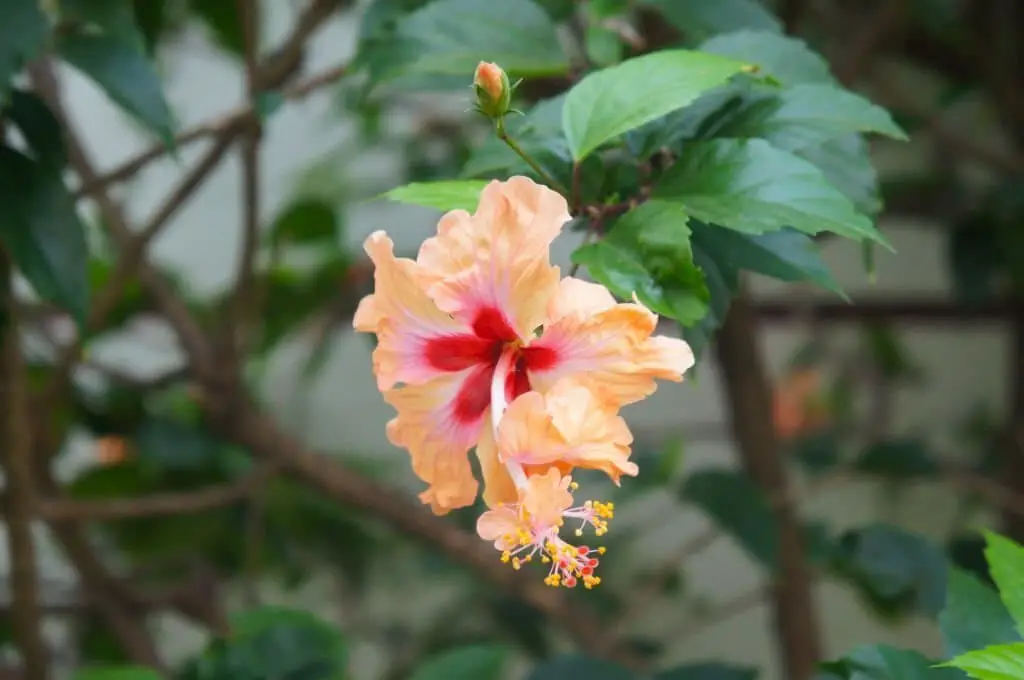
Hibiscus rosa-sinensis ‘El Capitolio’, a tropical hibiscus variety, boasts large, vibrant blooms in shades of red and yellow, making it an excellent addition to any garden. This striking plant can thrive as both a potted beauty and an outdoor shrub. Its parentage is rooted in the early twentieth century, when Cuban botanists created the hybrid by crossing Hibiscus rosa-sinensis with Hibiscus mutabilis.
The name ‘El Capitolio’ pays homage to the iconic Cuban National Capitol Building where this stunning variety was first cultivated. Notably, the flowers of Hibiscus rosa-sinensis ‘El Capitolio’ are particularly showy, reaching a diameter of up to 12 cm and featuring a dark center amidst their red or yellow hues. As new growth is essential for flowering, regular pruning is crucial to encourage this plant’s vibrant blooms.
Hibiscus rosa-sinensis ‘Eye of Kali’ (Hibiscus ‘Eye of Kali’)
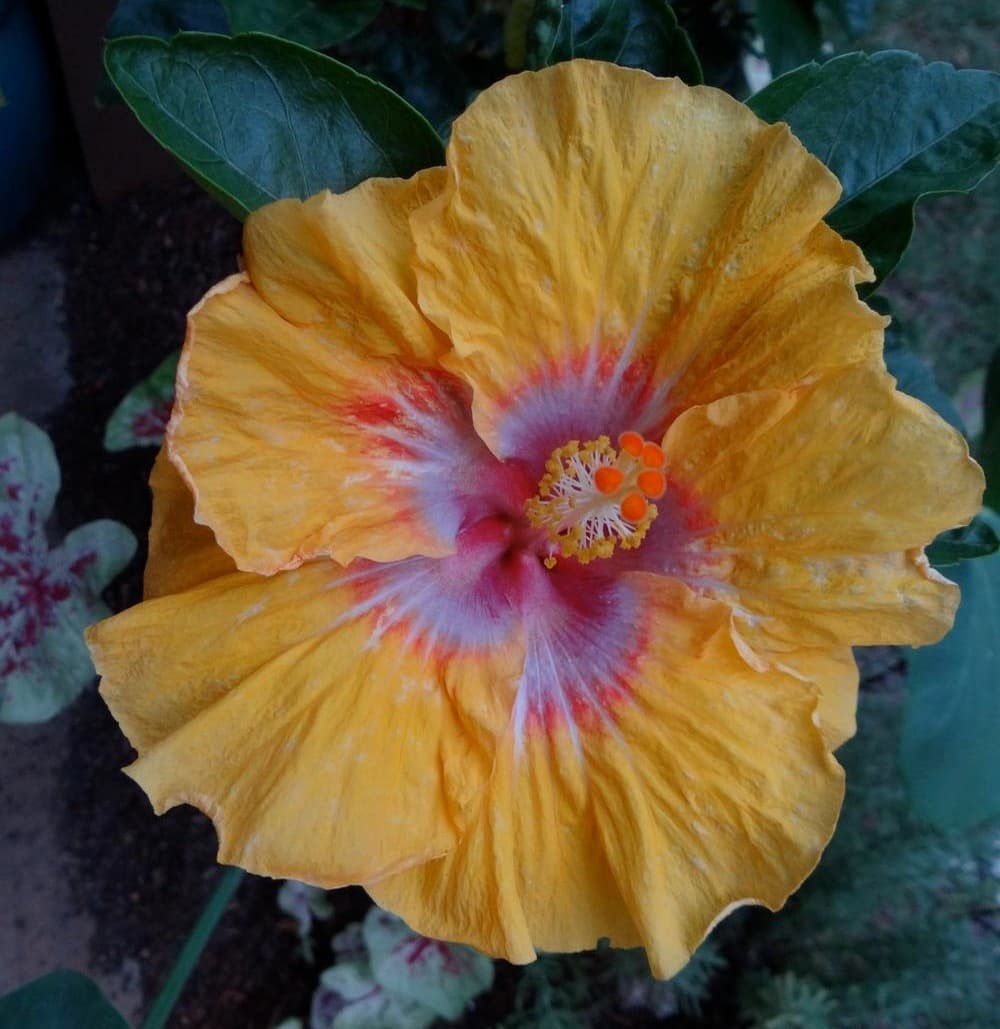
Hibiscus rosa-sinensis ‘Eye of Kali’ is a striking tropical hibiscus, boasting deep maroon blooms with vibrant yellow centers. This relatively new cultivar, introduced in 2006, is the result of a carefully crafted hybrid between Hibiscus rosa-sinensis and Hibiscus schizopetalus. Its enigmatic name pays homage to the Hindu goddess Kali, often adorned with similar maroon flowers in her sacred locks.
Native to China and India, this tropical hibiscus was introduced to the West Indies in the 17th century, where it has since thrived in many tropical regions worldwide. A vigorous grower, ‘Eye of Kali’ can reach impressive heights of over 12 feet, thriving in full sun to partial shade and well-drained soil. Its stunning beauty makes it an excellent addition to any garden, elevating its surroundings with a pop of vibrant color.
Hibiscus rosa-sinensis ‘Red Dragon’ (Tropical Hibiscus ‘Red Dragon’)
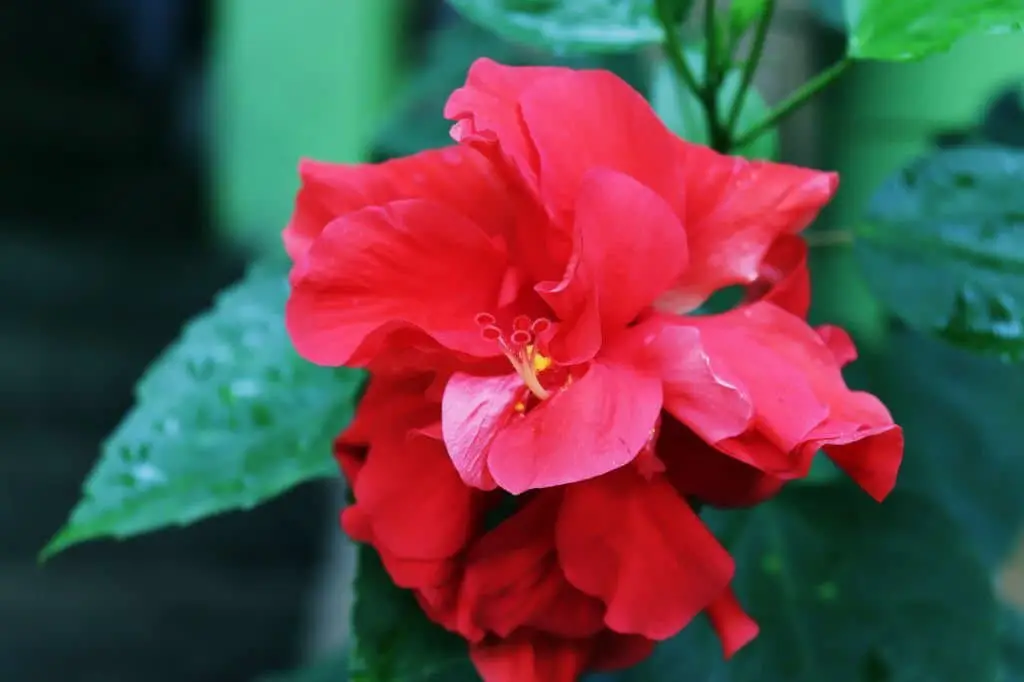
Hibiscus rosa-sinensis ‘Red Dragon” boasts stunning, tropical blooms characterized by massive, deep crimson flowers adorned with striking golden stamens. Its effortless cultivation and adaptability make it a standout choice for both outdoor gardens and containers alike. As this vibrant variety bursts into bloom during the summer months, continuing through autumn, it offers an extended period of radiant color.
Hibiscus sabdariffa (Roselle)
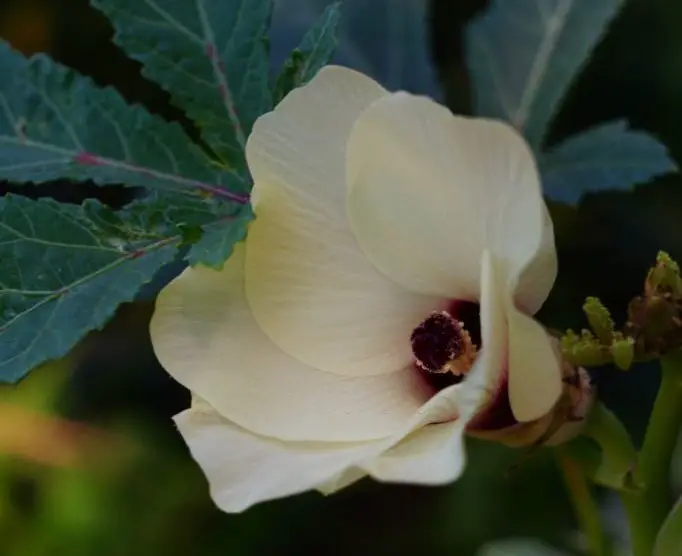
Native to West Africa, Hibiscus sabdariffa is an annual or perennial herbaceous plant that can grow up to 30 inches tall. Its deeply lobed leaves reach lengths of up to 30 cm and widths of 15 cm. The flowers are a striking feature, with large, round, bright red blooms measuring approximately 12 cm in diameter. The fruit, too, is an edible red capsule that can reach diameters of up to 15 cm, containing numerous black seeds.
For centuries, the plant has been used for medicinal purposes in Africa and Asia. In traditional Chinese medicine, it’s known as shi zhi (冰糖莲子), employed to cool the blood, lower cholesterol levels, and aid digestion. Additionally, Hibiscus sabdariffa is used as a natural food colorant, with its red calyces imparting a pink or red hue to beverages like herbal teas and punches.
Hibiscus schizopetalus (Spider hibiscus)
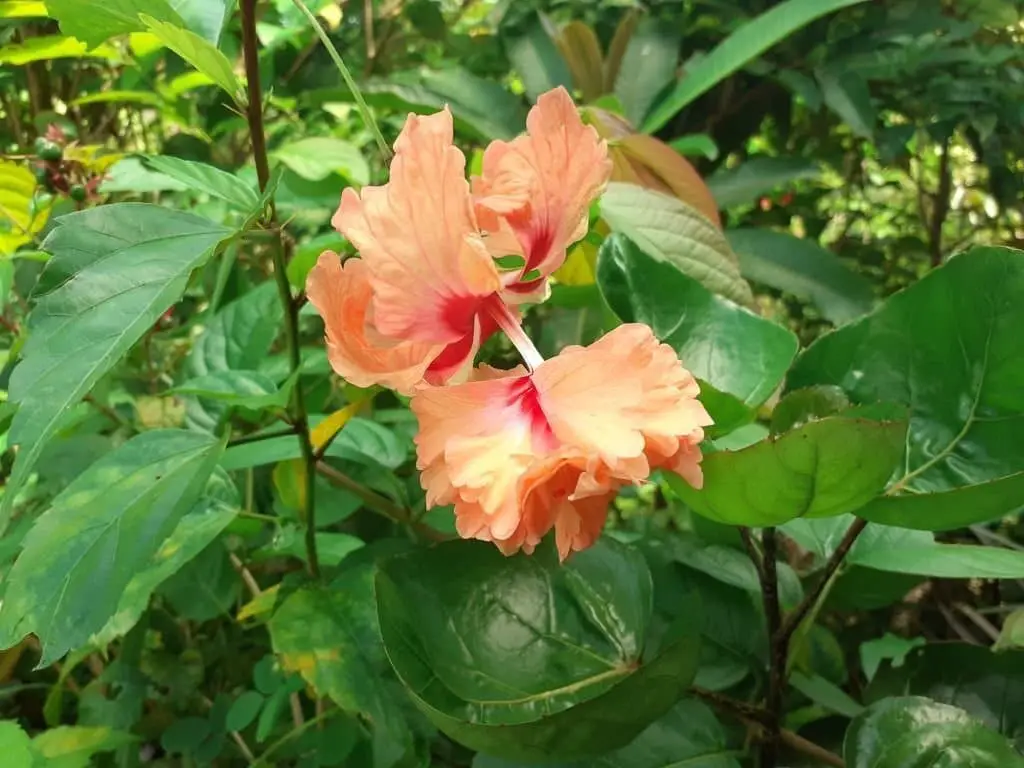
A stunning tropical flowering plant, Hibiscus schizopetalus, also referred to as spider hibiscus, is a true marvel of nature. Its natural habitat spans across Mexico and Central America, but its beauty has spread to other warm regions globally. Characterized by its striking flowers featuring five prominent petals, which often take on deep red or purple hues, this plant is a treat for the eyes.
The vibrant blooms also play host to hummingbirds and butterflies, serving as a vital source of sustenance for these tiny creatures.
Hibiscus splendens (splendid hibiscus)
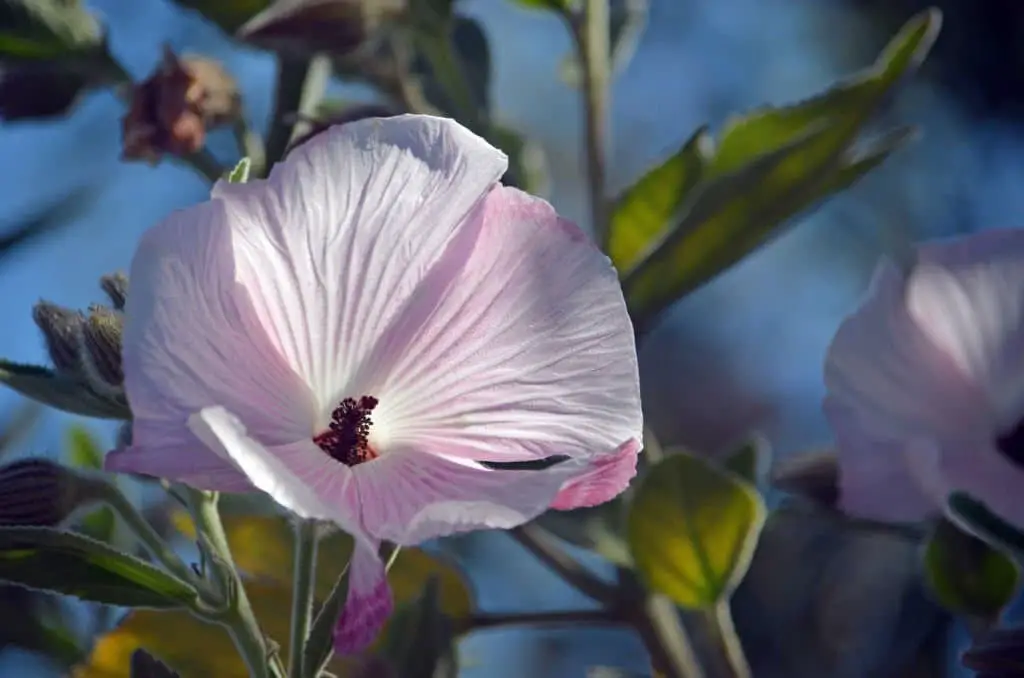
Hibiscus splendens, a native of the Indian subcontinent, has gained immense popularity globally for its vibrant beauty and versatility. This evergreen shrub or small tree can grow up to 0 in height, boasting an array of striking features. Its leaves are oblong-elliptic in shape, with a glossy dark green hue and a paler margin, making them a sight to behold.
The true pièce de résistance, however, is the stunning flowers that burst forth in shades of deep red or magenta, accompanied by a distinctive white basal spot on each petal. This ornamental gem is widely cultivated in gardens worldwide, where it adds a pop of color and charm. Moreover, the flowers are sometimes harnessed to create a soothing herbal tea, further testament to its multifaceted appeal.
Hibiscus syriacus (Common Hibiscus)
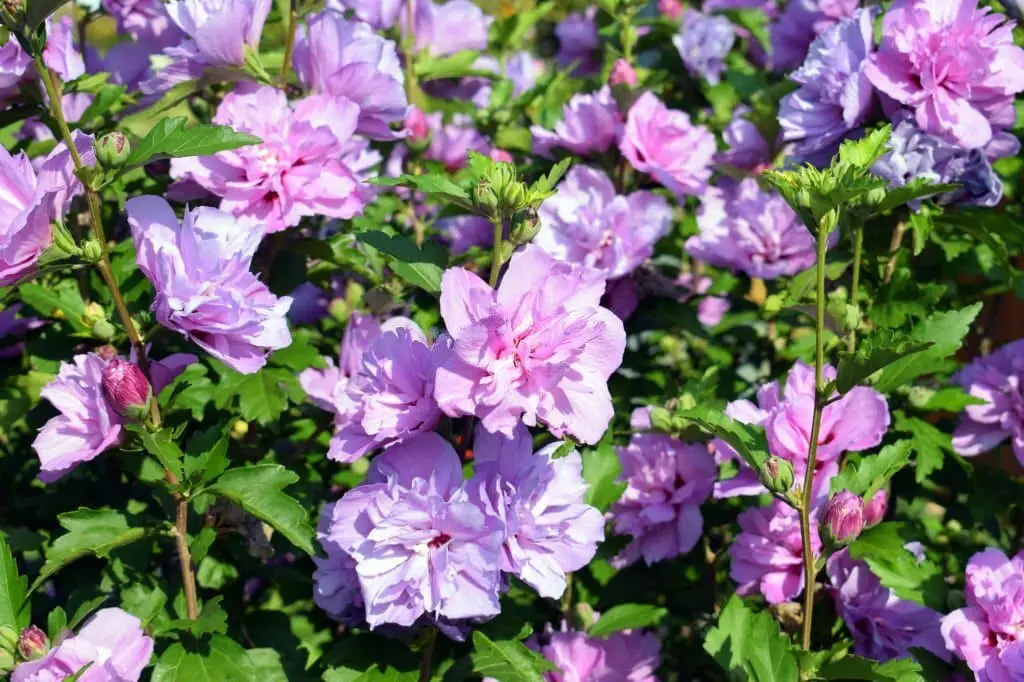
Hibiscus syriacus, a flowering plant in the Malvaceae family, is native to Asia and parts of Africa. Its popularity has led to widespread cultivation across tropical regions for ornamental purposes. This species boasts woody stems and vibrant flowers that range from deep red to white, featuring deeply lobed leaves with blooms reaching up to 15 cm (six inches) in diameter.
As a hardy perennial, it thrives in USDA zones four through nine, preferring full sun to partial shade and moist, well-drained soil. While drought-tolerant, regular watering encourages optimal flowering. Propagation is possible through seed or stem cuttings. Notoriously pest- and disease-free, Hibiscus syriacus may occasionally fall prey to aphids, whiteflies, spider mites, and scale insects.
Effective management involves insecticidal soap or horticultural oil sprays, ensuring the plant remains a stunning addition to any garden.
Hibiscus Syriacus ‘Aphrodite’
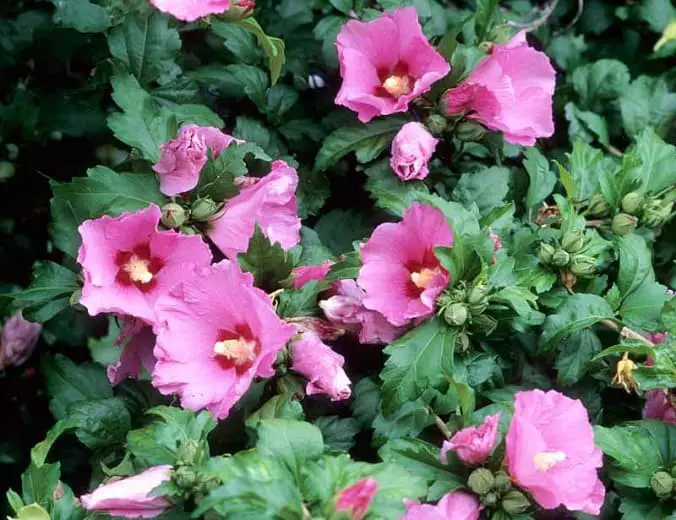
The Hibiscus Syriacus ‘Aphrodite’ is a stunning addition to any garden, boasting vibrant deep pink flowers and luscious glossy green leaves that provide visual interest throughout the seasons. This deciduous shrub thrives in full sun, although it can also tolerate partial shade. Its versatility makes it an excellent choice for borders, containers, or as a standalone specimen plant.
As a mid to late summer bloomer, Aphrodite produces flowers on its new growth, prompting gardeners to prune it back in early spring to encourage fresh foliage and an abundance of blooms. Notably, this low-maintenance shrub is also resistant to pests and diseases, making it a reliable addition to any garden.
Hibiscus syriacus ‘Oiseau Bleu’ (Rose of Sharon ‘Oiseau Bleu’)
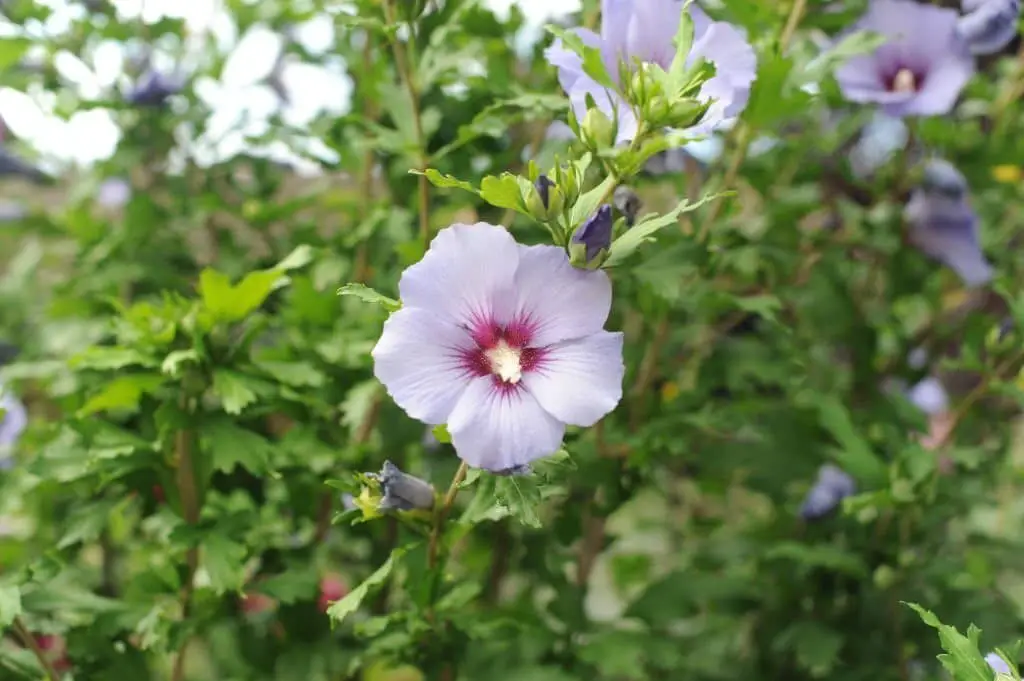
Hibiscus syriacus ‘Oiseau Bleu’ (Rose of Sharon ‘Oiseau Bleu’) is a showstopping deciduous shrub that brings vibrant color to the garden in late summer and early fall. Its impressive display of large, sky-blue flowers draws hummingbirds in droves, making it an excellent choice for attracting wildlife. This low-fuss shrub thrives in full sun to partial shade, requiring minimal upkeep.
‘Oiseau Bleu’ is a vigorous grower that can reach up to 12 feet tall and wide, so be sure to provide ample space for its sprawling habit.
Hibiscus Syriacus ‘White Chiffon’
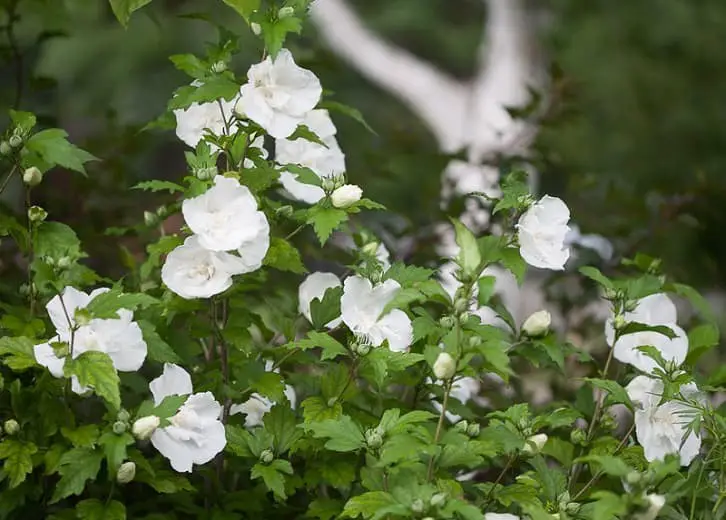
This evergreen shrub, Hibiscus Syriacus ‘White Chiffon’, stands out with its compact growth habit of around [insert dimension]. As the seasons transition from late spring to early fall, it showcases a stunning display of fragrant white flowers, filling the air with their sweet scent. A versatile choice for gardeners, ‘White Chiffon’ thrives in mixed borders, perennial gardens, or even as a low-maintenance hedge.
When it comes to growing conditions, Hibiscus Syriacus ‘White Chiffon’ prefers a spot that receives full sun to partial shade and benefits from moist, well-drained soil. While it can tolerate drought, it’s also resistant to common pests and diseases, making it an excellent addition to any garden.
Hibiscus trionum (flower-of-an-hour)
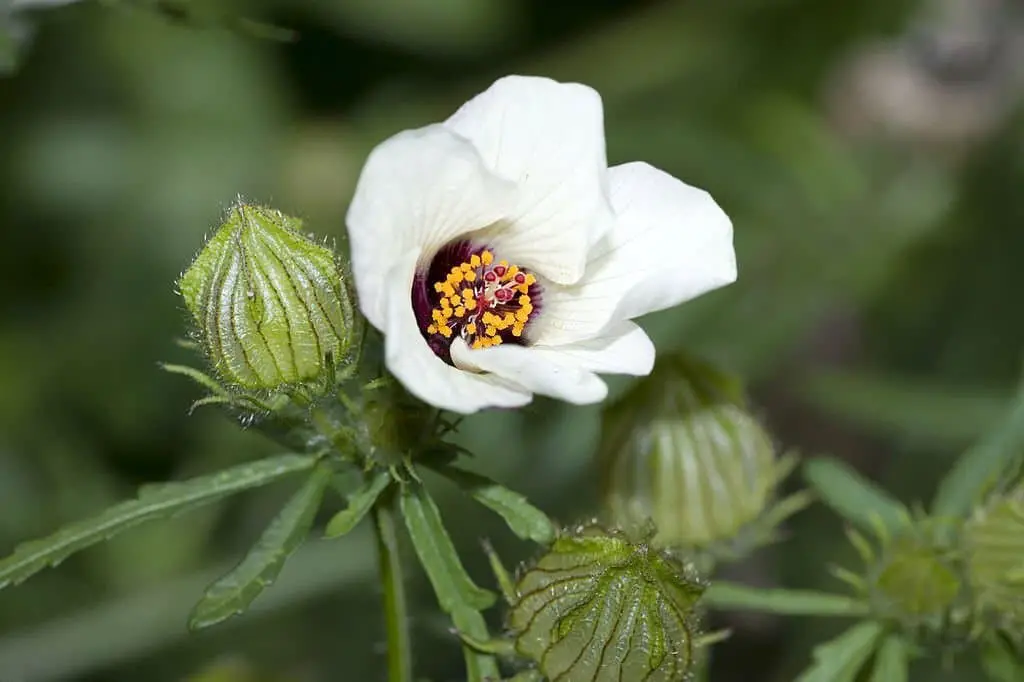
Hibiscus trionum stands at approximately two feet in height, its annual nature allowing it to thrive and flourish within a relatively short period. The plant’s vibrant flowers display a kaleidoscope of colors, ranging from pure whites to soft pinks and deep reds. A unique characteristic of Hibiscus trionum is the fleeting duration of its blooms, with each flower opening for only a single day before giving way to new growth.
For optimal blooming, Hibiscus trionum requires full sun exposure and well-drained soil conditions.
Hibiscus waimeae (white Kauai rosemallow, Kokiʻo keʻokeʻo)
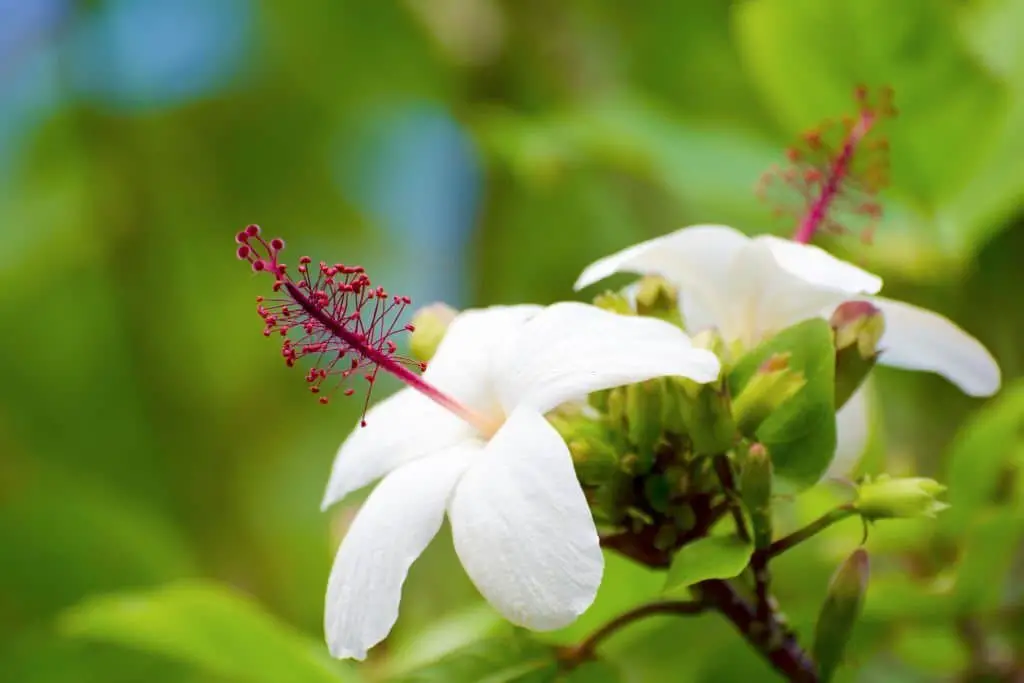
Hibiscus waimeae, also referred to as the white Kauai rosemallow, is an endemic species of hibiscus found exclusively on the island of Kauai in Hawaii. As part of the Hibiscus subgenus Hibiscus, it shares a close genetic relationship with Hibiscus brackenridgei. This diminutive shrub reaches a height of approximately 0.
75-meter (30-inches), characterized by dark green leaves bearing a distinctive reddish underside and white blooms featuring five petals that can stretch up to 12 centimeters (five inches) in diameter. The fruit, meanwhile, takes the form of a hairy capsule roughly half a centimeter long.
FAQs
What is the hardiest hibiscus?
The Rose of Sharon (Hibiscus syriacus) stands out as one of the most resilient hibiscus varieties. This deciduous shrub has a remarkable ability to thrive, growing up to 12 feet tall and wide. Its stunning blooms appear from mid-summer through fall, showcasing a vibrant array of colors including white, pink, purple, and blue. Notably, the Rose of Sharon is hardy in zones four through nine, making it an excellent choice for gardeners seeking to add some tropical flair to their outdoor spaces.
What colors do hardy hibiscus come in?
With their diverse palette of hues, hardy hibiscus varieties can be found in an array of colors such as white, pink, red, purple, and yellow. Some cultivars even boast multi-hued blooms that add a touch of whimsy to the garden. As a low-maintenance option for gardens, hardy hibiscus are particularly appealing due to their ability to provide vibrant splashes of color throughout the entire summer season.
Conclusion
With its vibrant hues and delicate charm, the hibiscus flower has captured the hearts of many garden enthusiasts. This stunning bloom comes in a wide range of colors, making it a versatile addition to any bouquet or arrangement. Its popularity extends beyond floral arrangements, as it’s also a lovely choice for gardeners looking to add some visual interest to their outdoor spaces.
When selecting hibiscus for your yard, remember to provide it with ample sunlight and water – with proper care, this beauty will flourish. Your pleasure in reading has been our reward.
Related Posts
When it comes to flower delivery, many of us wonder if we should tip our floral courier. In this sense, understanding gratuities becomes crucial in showing appreciation for the service provided. As we delve into the world of flowers, we also come across other intriguing topics such as identifying and removing weeds with yellow flowers, or choosing colorful perennials for partial shade gardens or containers.
Moreover, we learn how to grow and care for African violet plants, explore the Astilbe plant profile and tips for growing this flowering perennial in shady garden corners. Finally, we are given a list of top ten shade perennials suitable for cold climates, providing valuable tips on creating a lush shade garden.




